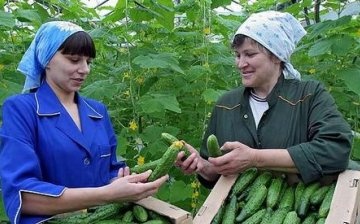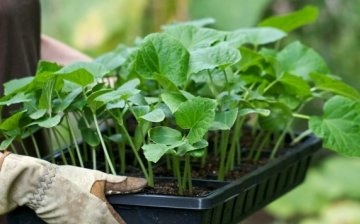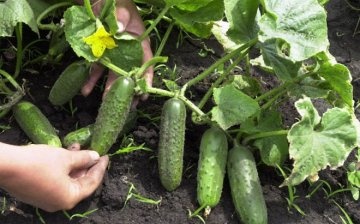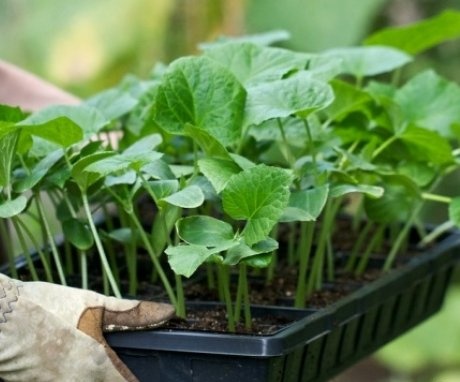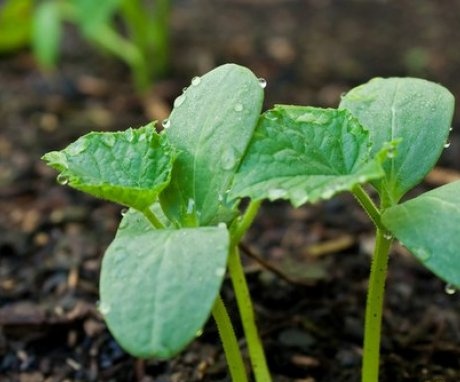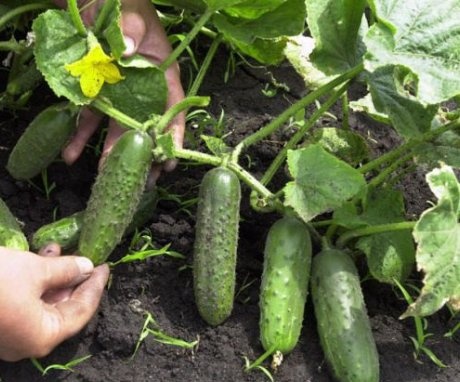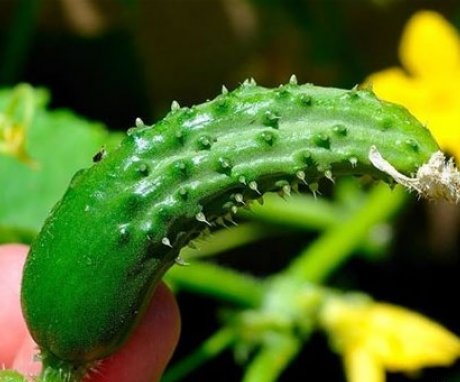Gardener's body of knowledge - how to properly grow cucumbers
Cucumber has become an integral part of our menu. The vegetable has become a part of our culture. Proper cultivation of cucumbers will guarantee a bountiful harvest. It is important for a novice gardener to have all the necessary knowledge for this responsible process. A quick guide will help you determine the variety, sowing and care method. The gardener will receive comprehensive knowledge of how to grow properly cucumbers.
Content:
- The best varieties of cucumbers
- Planting: seeds and seedlings
- Soil for cucumbers and planting dates
- Care rules
- Protection from pests and diseases
The best varieties of cucumbers
Before purchasing seeds cucumbers, you need to decide on their purpose. It is important to understand why they will be grown. Whether you just want to eat a fresh salad, or harvest for salting. More often you want both. The purpose of the culture was the emergence of the classification of the vegetable. Allocate:
- Early maturing varieties
- Mid-season vegetables
- Late cucumbers
Now the novice gardener already understands why you need to decide on the goal cultivation culture. The next criterion will be the location of the cucumber vines - a greenhouse or open ground.
This parameter has defined another small classification:
- Allocate parthenocarpic varieties
- Bee-pollinated species
With the second type of vegetable, everything is clear, it should grow in open ground, as it requires the presence of bees around. The first implies that there is no need for pollination. Rather, it is intended for greenhouses, greenhouses.
Having decided on these criteria, the gardener chooses between hybrid and varietal seeds.
Experienced gardeners prefer varietal varieties. Their essence boils down to the fact that grown vegetables are obtained the seeds for their later use. They retain all the genes of their parents. Each gardener has his own favorite variety; it is grown from year to year. Hybrid seeds cannot boast of this quality. Trying to grow a vegetable from their seeds is not worth it. They do not preserve hereditary information. Hybrids are grown once. This is the difference between these types of vegetable crops.
Depending on the destination and location, you can already purchase cucumber seeds. Gardeners prefer to grow the following varieties:
- Elegant (early maturing, bee-pollinated, size 10-15 cm, cold-resistant, not afraid of diseases)
- Nezhinsky 12 (mid-season, unpretentious, bee-pollinated, size 12 cm)
- Shrub (early maturing, bee-pollinated, not resistant to temperature extremes, considered the most delicious variety of cucumbers)
- Hybrid species are always designated "F1". Have proven themselves:
- Zyatek F1 (self-pollinated, suitable for open ground, high-yielding)
- Mother-in-law F1 (self-pollinated, unpretentious, disease resistant)
- Zozulya F1 (high-yielding, suitable for greenhouses and open ground, size up to 25 cm)
There are a large number of varieties and hybrids. Here you learned about the best, time-tested varieties.
Planting: seeds and seedlings
By choosing the seeds cucumbers, the gardener proceeds to prepare them. Usually, purchased seeds are already heat treated and dyed.They do not require special procedures, unlike seeds collected independently from the previous one. harvest... They must be warmed up and soaked in a solution of potassium permanganate. Many gardeners soak them in solutions with the addition of growth stimulants. These measures contribute to faster hatching of seeds.
To give the quality of resistance to low temperatures, they are soaked in plain water, wet gauze, and placed in the refrigerator for a day. It is important here that the seeds are not hatched. After hardening, the seedlings are processed according to the usual scheme: Hardening - soaking in potassium permanganate or stimulants.
After preparation, the sowing method is selected. It is of two types:
- Sowing on seedlings
- Sowing in open ground
Experienced gardeners recommend using the first planting method:
- First, the first cucumbers will appear two weeks earlier.
- Secondly, the overall yield increases - 25-30 fruits per square meter.
- Third, the plant grows strong. It is more resistant to temperature extremes.
Given our short summer, often cool, it is recommended to sow seeds on seedlings... They begin to grow it a month before planting in the ground - in early, mid-April.
Seedlings are planted in the greenhouse in mid-May, in open ground - in early June.
If you plan to sow the hatched seeds directly into the ground, this must be done in the already warmed up soil and under the film. The method proved to be bad due to poor germination of seedlings. It is better suited for well-equipped greenhouses.
Soil for cucumbers and planting dates
For seedlings a nutritious soil is being prepared. It is desirable to place it in peat pots:
- The mixture consists of the following components: humus (approximately 50%), peat (approximately 30% of the total composition) and sod land.
- Everything is thoroughly mixed and scattered into pots.
- You can add a little sawdust or sand.
- The soil should be warm and light.
In April, seeds are sown for seedlings. Small sprouts that appear indicate that they need to be moved to a shaded place. Otherwise, in the sun, they will stretch out more than the intended size. During the growth of seedlings, two times a day are produced. top dressing... For 10 liters of water, 15 g of potassium sulfate and 40 g of superphosphate are diluted. The first feeding is carried out after two leaves appeared. The second - before planting in a greenhouse or ground. Seedlings are planted after 3-4 leaves appear.
The soil for planting in the ground is prepared as follows:
- 1-2 buckets of manure with 20 g are mixed per square meter mineral fertilizer.
- The mixture is thoroughly mixed with earth. Wood sawdust and sand are often added.
- Wells are being formed. No need to dig deep! Estimate the size of the pot and, based on this, make indentations.
- Place the plant in the ground and bury it with soil.
- The hole should be well spilled with water.
Seedlings are planted in a greenhouse in mid-May, in open ground - in early June. When planting seedlings or seeds in open ground, the bed is covered with a film material. When the plant takes root and gets stronger, the film can be removed.
It is better to plant cucumbers in the places where they were grown tomato, potato or corn.
Vegetable culture loves fertile, light, humus-rich soil. It is very important to make a device for cucumber vines from the very beginning. Many gardeners build a trellis. She perfectly holds the stems of the plant. Vines must be attached to the support, otherwise, in an impassable, lying plant, it will appear powdery mildew... The yield will drop significantly.
Experienced gardeners advice! If the region is characterized by frequent and unexpected frosts, the soil must be pre-warmed. For this, ridges are built around the perimeter of tree branches, compost, humus, sawdust. All this is mixed with the ground and spilled with hot water (80 ° -90 °). As soon as the ground temperature drops to 20 ° -25 ° can be planted seedlings... A ditch around the perimeter will protect the root system from the cold. The planting and soil preparation scheme will allow you to harvest a good harvest and avoid many diseases cucumber... An important point is care and feeding plants during the growing season.
Care rules
During the growing season, cucumbers must be carefully weeded. At the initial stage of growth in the soil, the holes are loosened, but not deeply. Cucumber Is a moisture-loving vegetable. You need it to water as often as possible. It is advisable to use warm rainwater, which can easily be collected in an empty, open barrel. For the entire period of growth, the plant is fed 5-6 times, depending on its location - a greenhouse or open ground.
Top dressing:
- In the open field, four times a day feeding is enough. It is a mixture of 10 liters of water, a teaspoon of potassium sulfate and half a liter mullein... Any humic fertilizer can be used instead of the last ingredient. For example, "Breadwinner", "Ideal", "Fertility".
- The same composition can be used for feeding plants in the greenhouse. The only difference is in the amount of dressings. In the greenhouse, it will be 5 times per season. The first 2-3 feeding is carried out up to flowering and fruiting. The rest during the period of fruit ripening.
The rules for caring for a vegetable include its constant garter as it grows to the trellis. This is done in order to avoid the appearance of powdery mildew and increase yields. At the initial stage of growth, 6-7 leaves, pinch the central stem, thereby provoking branching of the vegetable culture. This measure helps to increase yields. During fruiting, cucumbers should be removed on time. This will again increase and accelerate the growth of the fruit.
If the weather forecast broadcasts about frost, and your cucumbers are growing in the open field, be sure to prepare a covering material.
It can be a regular film or non-woven fabric. Cover the cucumbers at night, press the film with bricks. This measure will help protect the plant from death. Care can include disease tracking and pests cucumbers. Control and prevention is a constant element in the cultivation of any vegetable crop.
Protection from pests and diseases
In order to successfully grow tasty cucumbers, it is necessary not only to properly care for them, but also to constantly monitor their condition. The gardener should periodically inspect leaves and ovaries, fruits for the presence of disease or pests... Take all preventive measures to prevent the arrival of uninvited guests.
Knowledge of the types of ailments of the cucumber and its pests will help the gardener take timely measures to destroy them.
It is customary to distinguish several of the most common diseases of vegetable crops:
- Powdery mildew (whitish spots on the leaf and stem; sprayed infusion of cow dung).
- Cladosporium (dark spots on fruits and leaves; treatment with Bordeaux liquid).
- Sclerotinia (white fungus throughout the plant; the plant is treated with lime and coal powder).
- Fusarium wilt (the whole plant withers instantly; control measures do not help; as a preventive measure, the soil is treated with a manganese solution) ..
- White and green mosaic (the fruits are affected by spots, lose their taste; the plant is transplanted to a healthy area)
Among the pests of vegetable crops, there are several that are most dangerous for cucumbers:
- Spider mite (whitish cobweb on leaves and fruits; the plant is treated with BI-58).
- Gall nematode (the disease is characteristic only for greenhouse plantings, the root system is affected by brown growths; the soil is treated with Fitoverm, Agravertin).
- Cucumber gnat (larvae gnaw at the roots, the plant withers and dies; the soil is treated with BI-58 and Aktara preparations).
It is very simple to avoid the appearance of diseases and pests - prevention... This method is always preferable to dealing with an illness or parasite.Most pests and diseases appear in greenhouse structures. They must be processed and prepared before planting seedlings. Glass and other elements of the greenhouse are washed with either a chlorine solution or potassium permanganate. The soil is disinfected with the same potassium permanganate or steamed at a temperature of 100 °. The soil and plants must be treated with insecticidal drugs.
The greenhouse should be periodically ventilated, excessive humidity provokes the appearance of pests and diseases.
Follow the rules whenever possible crop rotation... In the fall, plow the soil deeply and destroy all vegetation. Simple preventive measures will save the cucumber crop. The gardener will be proud of the grown juicy and tasty cucumbers.
A gardener's quick guide told you about the golden rules for growing cucumbers. Compliance with all rules and regulations for care, planting and preventive measures will allow you to harvest a large harvest, salt delicious gherkins and make a fragrant, fresh salad. Good luck in growing a valuable crop!
More information can be found in the video.




